Isn’t modern society great? With all this technology surrounding us in all directions. It’s like a cocoon of sweet, fluffy silicon. There are chips in my fitness tracker, my bluetooth headset, mobile phone, car keys and that’s just on my body.
At all times in the Cain household, there dozens of internet devices connected to my wifi router. I’m not sure how we got to the point, but there’s one thing I know for sure, more is better. If I could use two smartphones at the same time, I totally would.
And I’m sure you agree, that without all this technology, life would be a pale shadow of its current glory. Without these devices, we’d have to actually interact with each other. Maybe enjoy the beauty of nature, or something boring like that.
It turns out, that terrible burning orb in the sky, the Sun, is fully willing and capable of bricking our precious technology. It’s done so in the past, and it’s likely to take a swipe at us in the future.
I’m talking about solar storms, of course, tremendous blasts of particles and radiation from the Sun which can interact with the Earth’s magnetosphere and overwhelm anything with a wire.
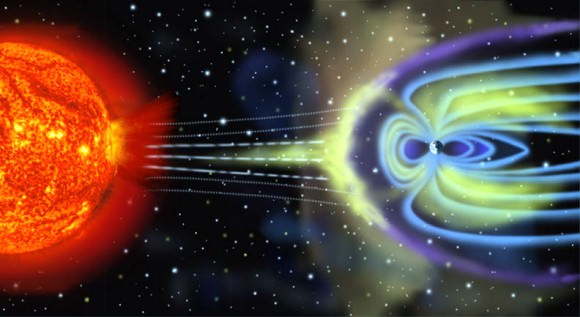
In fact, we got a sneak preview of this back in 1859, when a massive solar storm engulfed the Earth and ruined our old timey technology. It was known as the Carrington Event.
Follow your imagination back to Thursday, September 1st, 1859. This was squarely in the middle of the Victorian age.
And not the awesome, fictional Steampunk Victorian age where spectacled gentleman and ladies of adventure plied the skies in their steam-powered brass dirigibles.
No, it was the regular crappy Victorian age of cholera and child labor. Technology was making huge leaps and bounds, however, and the first telegraph lines and electrical grids were getting laid down.
Imagine a really primitive version of today’s electrical grid and internet.
On that fateful morning, the British astronomer Richard Carrington turned his solar telescope to the Sun, and was amazed at the huge sunspot complex staring back at him. So impressed that he drew this picture of it.
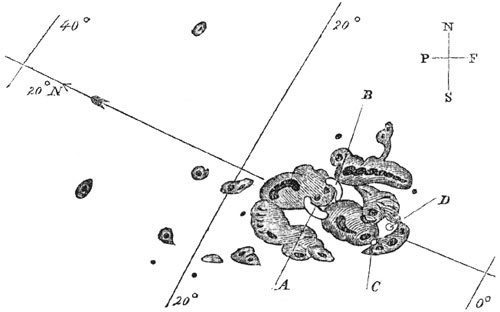
While he was observing the sunspot, Carrington noticed it flash brightly, right in his telescope, becoming a large kidney-shaped bright white flare.
Carrington realized he was seeing unprecedented activity on the surface of the Sun. Within a minute, the activity died down and faded away.
And then about 5 minutes later. Aurora activity erupted across the entire planet. We’re not talking about those rare Northern Lights enjoyed by the Alaskans, Canadians and Northern Europeans in the audience. We’re talking about everyone, everywhere on Earth. Even in the tropics.
In fact, the brilliant auroras were so bright you could read a book to them.
The beautiful night time auroras was just one effect from the monster solar flare. The other impact was that telegraph lines and electrical grids were overwhelmed by the electricity pushed through their wires. Operators got electrical shocks from their telegraph machines, and the telegraph paper lit on fire.
What happened? The most powerful solar flare ever observed is what happened.
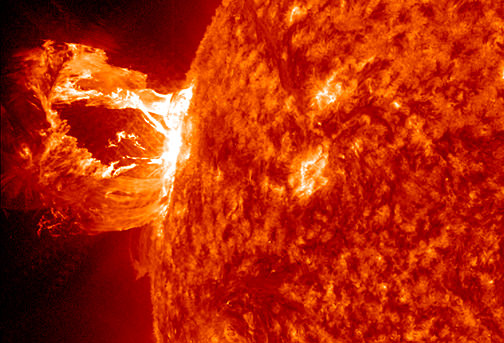
A solar flare occurs because the Sun’s magnetic field lines can get tangled up in the solar atmosphere. In a moment, the magnetic fields reorganize themselves, and a huge wave of particles and radiation is released.
Flares happen in three stages. First, you get the precursor stage, with a blast of soft X-ray radiation. This is followed by the impulsive stage, where protons and electrons are accelerated off the surface of the Sun. And finally, the decay stage, with another burp of X-rays as the flare dies down.
These stages can happen in just a few seconds or drag out over an hour.
Remember those particles hurled off into space? They take several hours or a few days to reach Earth and interact with our planet’s protective magnetosphere, and then we get to see beautiful auroras in the sky.
This geomagnetic storm causes the Earth’s magnetosphere to jiggle around, which drives charges through wires back and forth, burning out circuits, killing satellites, overloading electrical grids.
Back in 1859, this wasn’t a huge deal, when our quaint technology hadn’t progressed beyond the occasional telegraph tower.
Today, our entire civilization depends on wires. There are wires in the hundreds of satellites flying overhead that we depend on for communications and navigation. Our homes and businesses are connected by an enormous electrical grid. Airplanes, cars, smartphones, this camera I’m using.
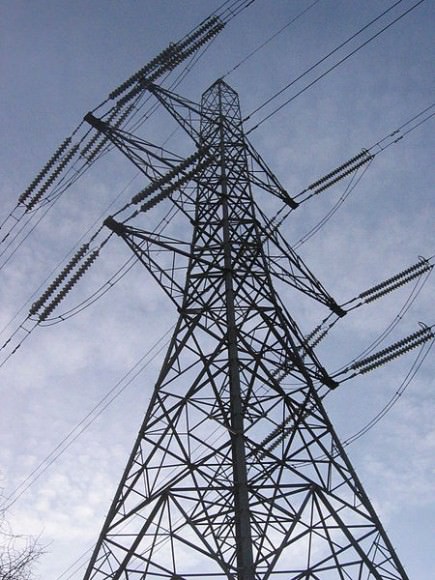
Everything is electronic, or controlled by electronics.
Think it can’t happen? We got a sneak preview back in March, 1989 when a much smaller geomagnetic storm crashed into the Earth. People as far south as Florida and Cuba could see auroras in the sky, while North America’s entire interconnected electrical grid groaned under the strain.
The Canadian province of Quebec’s electrical grid wasn’t able to handle the load and went entirely offline. For 12 hours, in the freezing Quebec winter, almost the entire province was without power. I’m telling you, that place gets cold, so this was really bad timing.
Satellites went offline, including NASA’s TDRS-1 communication satellite, which suffered 250 separate glitches during the storm.
And on July 23, 2012, a Carrington-class solar superstorm blasted off the Sun, and off into space. Fortunately, it missed the Earth, and we were spared the mayhem.
If a solar storm of that magnitude did strike the Earth, the cleanup might cost $2 trillion, according to a study by the National Academy of Sciences.
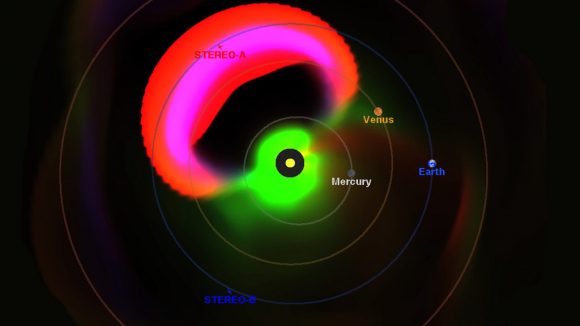
It’s been 160 years since the Carrington Event, and according to ice core samples, this was the most powerful solar flare over the last 500 years or so. Solar astronomers estimate solar storms like this happen twice a millennium, which means we’re not likely to experience another one in our lifetimes.
But if we do, it’ll cause worldwide destruction of technology and anyone reliant on it. You might want to have a contingency plan with some topic starters when you can’t access the internet for a few days. Locate nearby interesting nature spots to explore and enjoy while you wait for our technological civilization to be rebuilt.
Have you ever seen an aurora in your lifetime? Give me the details of your experience in the comments.


Like Richter 10 earthquakes, earth-ward Carrington-level SME’s are something that cannot be predicted on some kind of schedule, only that they will eventually come.
Of all disasters, I regard a modern CE as something that will be globally catastrophic, if it occurs in the middleof a northern winter. You cannot send out repair trucks to satellites with fused electronics. If thousands of substation transformers across Canada, Europe, and Russia are burned out directly (almost a sort of EMP effect) so that blown fuses and breakers cannot be of any protective use, there will be little point in sending out trucks and cranes to haul them out and replace them, if even half of them have replacements ready at all. It probably won’t be a few transformers in a given station, it will be almost all of them.
After 4-5 days, transportation, industry, commerce and telecom will have simply been shut down irrecoverably. There will be no internal capacity to bootstrap their functions.
The North supplies the South with vital finished goods, and takes in raw materials from around the world. The South is not a redundant system that can re-light both its own and the North’s technological candle.
What the South will do is provide a warm place to start scratching in the soil to grow seed, to preserve books, to teach children the basic math, science, and tech, when its remaining internet resources fail, and bring back civilization in a slow and painstaking procedure that will reclaim a clock set back by at least a hundred years.
[doing htm tags by hand has its risks. I wish U.T. had post-editing available]
“…if it occurs in the middle of a northern winter. You cannot send out repair trucks…”
This would only provide enough current to cause a problem in large wiring systems, if a flare was powerful enough to fry smartphones and small electronics on terra firma then lack of electricity would be the least of our worries. Your scenario does, however, show the disater potential of a high-tech society relying entirely on centralised power generation controlled by centralised corporations. Get those solar cells/windgen and your Powerwalls now, whether you’re a home or a factory.
When a CME hits us, there are tremendous voltages induced in every ‘wire’ on or near the Earth because our magnetosphere flexes. A ‘Wire’ and a ‘Magnetic field’ in ‘motion’ creates electricity.
These voltages produced are so large they will overcome the insulation resistance in large transformers (power plants, sub stations, your telephone pole). The voltage spike can ‘short out the insulation between windings causing the transformer to fail. We are talking 500 Killo Volts or more.
When these high voltage spikes arrive at another transformer down the line, the voltage spike will multiply according to the ‘step-up/step-down’ ratio of the transformer.
These voltage spikes will fry all your plugged in electrical equipment, will arc across the tiny spaces in your light switches, dance around your bedroom like Saint Elmo’s Fire, overcome the electrical insulation in your walls and set fire to your house.
These induced voltages are dependent on the length of the wire and if there are any ‘coils’ involved. I wouldn’t be surprised if the voltages induced in an unplugged piece of electronics equipment were enough to fry the semi-conductors (transistors, chips, etc) and ruin the equipment.
Cell phones might survive, but the cell towers would be toast. The electrical grid would be out for at least a month and no electrical power to run the cell phone towers, your AC, forced air furnace, lights, water (operated by electric pumps), or gas at your local gas station (electrical pumps and computer driven equipment).
It would be like Florida right after a major hurricane. If you had a large enough gasoline powered generator in the back of your pickup truck (3 KW or more) you might be able to barter a few hours of your electricity for some gasoline…
Everything would become Cash or Barter. No credit cards would work (no electricity for the machines). No cell phones, no internet, no TV, no computers, no lights, no electric cooking, no microwave, Oh yeah, no water pressure would also mean no ‘flush toilets’.
Cars with computer controls for ignition, fuel injection, etc, could fail as well and your neighbors might come to siphon out some of your gas for the few cars that would still be able to run…
It could get interesting. If you are riding in a ‘self driving car’ and the engine fails, you are riding in an Unguided Missile with no steering and no brakes. These operations are mostly electrical or electronic in these new ‘wonders’.
Saw an unusual aurora in northeast Texas in very early March 1986. It consisted of rapidly moving streamers over the top of the dome of the sky. To the east was a large, very bright, very red amorphous cloud. To the SE was a smaller green cloud. I watched this from about 7pm to 1030pm, and it was continuing when I went home. On the news, there was a report of a “fire” in the east, but the source couldn’t be localized. I read later that this same “fire” mistake was made by the Romans 2000 years ago. Can you correlate this to any prominent solar flares reported at that time?
So what’s going to happen to my future self-driving car when the GPS goes out? I sure hope it’s going to have a steering wheel.
Your choice of the article picture is good, this is Salisbury UK in 1870 painted by Louse Rayner ten years after the Carrington event. Look closely and see where you have to be developmentally for such an event to be no big deal.
Coronal Mass Ejection is the main argument of some people in Germany to put the new high voltage transmission lines carrying the electricity generated by wind power in North Germany to Bavaria underground, in spite of it costing double what it costs for above ground systems.
Re: my first and only aurora sighting. It was on a half-full flight from Amsterdam to Oslo in 2005 so I think the captain had to trim the plane as everyone moved over to one side to see it. From 30,000 feet it arched across the sky like a giant, luminous green umbrella, I’ve never seen anything so hauntingly beautiful. I wasn’t alone in having tears in my eyes and everyone was silent in awe.
I saw an aurora from suburban Melbourne, Australia in the 1980’s, before my interest in astronomy emerged.
I was innebriated, standing in my back yard in the suburb of Caulfield, and noticed shifting sheets of coloured light low in the south. I didn’t realize what it was at the time, in my befuddled state, and it was only on reflection the next day that I realized what I had witnessed.
Thanks Frazer for the great article !
Quoting Fraser
“…You might want to have a contingency plan with some topic starters when you can’t access the internet for a few days. Locate nearby interesting nature spots to explore and enjoy while you wait for our technological civilization to be rebuilt….”
Haha (and a mock suit and underground bunker with Yatze & boardgames too 😉 .. Thanks Fraser – and thanks everyone here for commenting.. I wish more noise would be made, it really is ok to be very concerned..
In addition to 2012 and Quebec mentioned in the article, there is also the 2003 Halloween super solar storm (which barely glanced past earth):
“… The strongest types of solar flares are known as X-class solar storms, and the 2003 event initially ranked a massive X28 on the space weather scale. That strength level, however, was later boosted up to X45 after more study, according to NASA records….
http://www.space.com/23396-scary-halloween-solar-storm-2003-anniversary.html
The Carrington event has been estimated to have been X45
http://www.swsc-journal.org/articles/swsc/pdf/2013/01/swsc130015.pdf
The real problem for our society would be that all large AC transformers would be fried from GIC (starting at X10 and if direct-on (straight shot from sun to earth) CME strike of X45 probably global AC transformer destruction)…
https://en.wikipedia.org/wiki/Geomagnetically_induced_current
The problem is these Transformers take Years to build.. And getting China on the blower to fab some more won’t be an option as electricity is required to manufacture.. Bad chicken-egg.. Bad chicken!!
Then there are the (100’s of hot fission) nuclear plants that can only run on diesel for 30 days until meltdown…
Let’s all make some noise to at least research contingencies for our electrical grid…
That concludes the post – thanks for reading.. Thanks again Fraser…
Weeasle